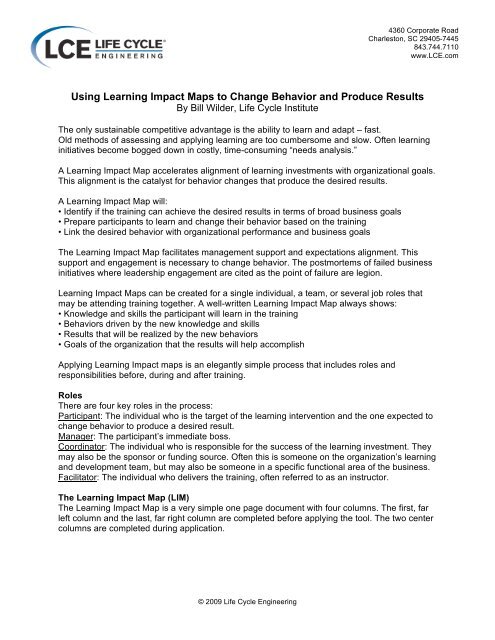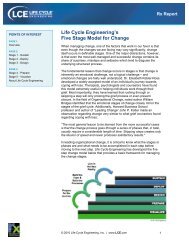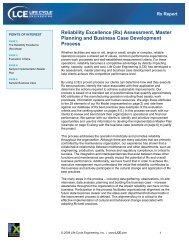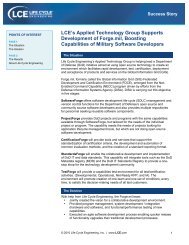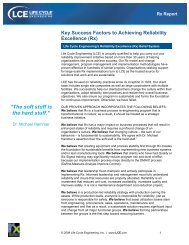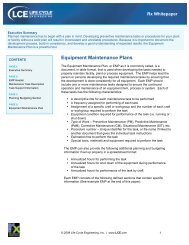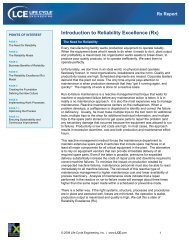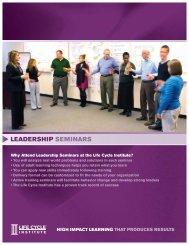Learning Impact Maps - Wilder - Life Cycle Engineering
Learning Impact Maps - Wilder - Life Cycle Engineering
Learning Impact Maps - Wilder - Life Cycle Engineering
You also want an ePaper? Increase the reach of your titles
YUMPU automatically turns print PDFs into web optimized ePapers that Google loves.
4360 Corporate Road<br />
Charleston, SC 29405-7445<br />
843.744.7110<br />
www.LCE.com<br />
Using <strong>Learning</strong> <strong>Impact</strong> <strong>Maps</strong> to Change Behavior and Produce Results<br />
By Bill <strong>Wilder</strong>, <strong>Life</strong> <strong>Cycle</strong> Institute<br />
The only sustainable competitive advantage is the ability to learn and adapt – fast.<br />
Old methods of assessing and applying learning are too cumbersome and slow. Often learning<br />
initiatives become bogged down in costly, time-consuming “needs analysis.”<br />
A <strong>Learning</strong> <strong>Impact</strong> Map accelerates alignment of learning investments with organizational goals.<br />
This alignment is the catalyst for behavior changes that produce the desired results.<br />
A <strong>Learning</strong> <strong>Impact</strong> Map will:<br />
• Identify if the training can achieve the desired results in terms of broad business goals<br />
• Prepare participants to learn and change their behavior based on the training<br />
• Link the desired behavior with organizational performance and business goals<br />
The <strong>Learning</strong> <strong>Impact</strong> Map facilitates management support and expectations alignment. This<br />
support and engagement is necessary to change behavior. The postmortems of failed business<br />
initiatives where leadership engagement are cited as the point of failure are legion.<br />
<strong>Learning</strong> <strong>Impact</strong> <strong>Maps</strong> can be created for a single individual, a team, or several job roles that<br />
may be attending training together. A well-written <strong>Learning</strong> <strong>Impact</strong> Map always shows:<br />
• Knowledge and skills the participant will learn in the training<br />
• Behaviors driven by the new knowledge and skills<br />
• Results that will be realized by the new behaviors<br />
• Goals of the organization that the results will help accomplish<br />
Applying <strong>Learning</strong> <strong>Impact</strong> maps is an elegantly simple process that includes roles and<br />
responsibilities before, during and after training.<br />
Roles<br />
There are four key roles in the process:<br />
Participant: The individual who is the target of the learning intervention and the one expected to<br />
change behavior to produce a desired result.<br />
Manager: The participant’s immediate boss.<br />
Coordinator: The individual who is responsible for the success of the learning investment. They<br />
may also be the sponsor or funding source. Often this is someone on the organization’s learning<br />
and development team, but may also be someone in a specific functional area of the business.<br />
Facilitator: The individual who delivers the training, often referred to as an instructor.<br />
The <strong>Learning</strong> <strong>Impact</strong> Map (LIM)<br />
The <strong>Learning</strong> <strong>Impact</strong> Map is a very simple one page document with four columns. The first, far<br />
left column and the last, far right column are completed before applying the tool. The two center<br />
columns are completed during application.<br />
© 2009 <strong>Life</strong> <strong>Cycle</strong> <strong>Engineering</strong>
Applying <strong>Learning</strong> <strong>Impact</strong> <strong>Maps</strong><br />
Before Training<br />
The coordinator works with the leadership and the facilitator to complete the first and last<br />
columns of the <strong>Learning</strong> <strong>Impact</strong> Map. <strong>Learning</strong> investments are made to advance the success<br />
of the organization by advancing specific goals. The starting point for using the map is the last<br />
column on the far right, which identifies the organization goals advanced by the learning<br />
objectives.<br />
The learning objectives are described in the first column on the left. While the training may seek<br />
to fulfill many objectives, the key here is to focus on a few. Less is more. Three specific, active,<br />
measureable objectives is a practical number. This is completed in advance by the coordinator<br />
with input from the manager and facilitator.<br />
The coordinator schedules time with the managers of the participants to describe the manager’s<br />
role and secure their commitment to fulfill it. During this scheduled time, the coordinator:<br />
• Reviews the organizational goals<br />
• Describes the training learning objectives<br />
• Impresses on the manager how their engagement will impact the desired behavior change<br />
• Demonstrates how to “read” the LIM<br />
• Provides questions for the manager to use in the pre-training meetings with participants,<br />
including:<br />
© 2009 <strong>Life</strong> <strong>Cycle</strong> <strong>Engineering</strong>
o<br />
o<br />
o<br />
What are the business results you personally impact the most?<br />
What are the key areas of training that can impact these results?<br />
What are some actions you might take after training to reach these results?<br />
Once prepared, the manager leads a meeting with the participant to complete the LIM. The<br />
meeting should be held three to seven days before the class. The meeting can be as short as<br />
15 minutes and it may be conducted in person or on the telephone.<br />
The coordinator collects copies of the completed LIM for each participant.<br />
The coordinator delivers copies of the LIMs to the training facilitator/instructor.<br />
During the Training<br />
Class participants update and revise their LIMs as necessary based on what they have learned<br />
in the class.<br />
The facilitator collects copies of the revised LIMs at the end of the class.<br />
After Training<br />
The facilitator provides the coordinator with a copy of their participant’s updated LIMs.<br />
The coordinator provides a copy of the LIM to the manager and reminds managers to schedule<br />
a follow up meeting within the first week after the training.<br />
The coordinator provides the manager with a list of questions to use in their post-training<br />
meetings:<br />
• What did you think of the training?<br />
• Why did you make the changes to your LIM?<br />
• What are the potential obstacles?<br />
• How can I support you?<br />
• Ask the employee to summarize the actions he/she will take to implement learning and<br />
summarize the actions you will take to support them.<br />
• Agree on how you will jointly monitor/measure progress.<br />
The manager leads a meeting with the participant and documents the results.<br />
The coordinator follows up with managers 7-10 days after the training to:<br />
• Determine if they have met with their program participants<br />
• Find out how the conversations went (what went well, what could have gone better)<br />
• Address any concerns/questions<br />
Following this process will make learning faster and more effective. Using <strong>Learning</strong> <strong>Impact</strong><br />
<strong>Maps</strong> helps you discern if the learning intervention will produce results that advance<br />
organizational goals. The process establishes the expectations and leadership alignment that<br />
facilitate application of the new knowledge and skills. It will save you time and money while<br />
producing documented results.<br />
Bill <strong>Wilder</strong> is the Director of The <strong>Life</strong> <strong>Cycle</strong> Institute at <strong>Life</strong> <strong>Cycle</strong> <strong>Engineering</strong> (LCE). Bill holds a Masters of Education<br />
degree from East Tennessee State University and a Bachelors of Science in Human Resources. Bill has more than<br />
25 years experience creating learning environments that help employees reach their highest potential. You can reach<br />
Bill at bwilder@LCE.com.<br />
© 2009 <strong>Life</strong> <strong>Cycle</strong> <strong>Engineering</strong>


